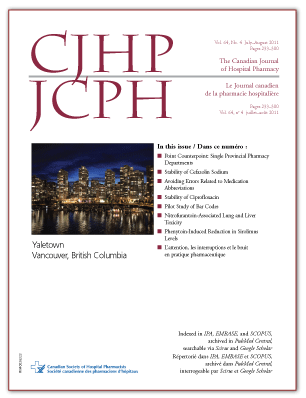A Pilot Study of Bar Codes in a Canadian Hospital
DOI:
https://doi.org/10.4212/cjhp.v64i4.1038Keywords:
bar-coding, pharmaceutical products, packaging code-barres, produits pharmaceutiques, conditionnementAbstract
ABSTRACT
Background: In 2004, the US Food and Drug Administration issued a new rule requiring most prescription and some over-the-counter pharmaceutical products to carry bar codes down to the level of individual doses, with the intent of reducing the number of medication errors. Despite these regulatory changes in the United States, Health Canada has not yet adopted any mandatory bar-coding of drugs.
Objective: To evaluate the feasibility of using commercial bar codes for receipt and preparation of drug products and to evaluate the readability of the bar codes printed on various levels of drug packaging.
Methods: This cross-sectional observational pilot study was conducted in the Pharmacy Department of a Canadian mother–child university hospital centre in July 2010. For the purposes of the study, research drugs and cytotoxic drugs in various storage areas, as well as locally compounded medications with bar codes generated in house, were excluded. For all other drug products, the presence or absence of bar codes was documented for each level of packaging, along with the trade and generic names, content (i.e., drug product), quantity of doses or level of packaging, therapeutic class (if applicable), type of bar code (1- or 2-dimensional symbology), alphanumeric value contained in the bar code, standard of reference used to generate the alphanumeric value (Universal Product Code [UPC], Global Trade Item Number [GTIN], or unknown), and readability of the bar codes by 2 scanners.Only 33 (1.9%) of the 1734 products evaluated had no bar codes on any level of packaging. Of the 2875 levels of packaging evaluated, 2021 (70.3%) had at least one bar code. Of the 2384 bar codes evaluated, 2353 (98.7%) were linear (1-dimensional) and 31 (1.3%) were 2- dimensional. Well over three-quarters (2112 or 88.6%) of the evaluated bar codes were readable by at least 1 of the 2 scanners used in the study.On the basis of these results, bar-coding could be used for receipt of 80.9% of the drug products at this Canadian hospital and for the preparation and dispensing of 70.1% of the products.
Results: Only 33 (1.9%) of the 1734 products evaluated had no bar codes on any level of packaging. Of the 2875 levels of packaging evaluated, 2021 (70.3%) had at least one bar code. Of the 2384 bar codes evaluated, 2353 (98.7%) were linear (1-dimensional) and 31 (1.3%) were 2- dimensional. Well over three-quarters (2112 or 88.6%) of the evaluated bar codes were readable by at least 1 of the 2 scanners used in the study.
Conclusions: On the basis of these results, bar-coding could be used for receipt of 80.9% of the drug products at this Canadian hospital and for the preparation and dispensing of 70.1% of the products.
RÉSUMÉ
Contexte : En 2004, la US Food and Drug Administration a mis de l’avant un nouveau règlement exigeant que la plupart des produits pharmaceutiques d’ordonnance et certains produits pharmaceutiques en vente libre portent des codes-barres, y compris les emballages unitaires, dans le but de réduire le nombre d’erreurs de médication. Malgré cette nouvelle réglementation aux États-Unis, Santé Canada n’a pas encore adopté un tel règlement au pays.
Objectif : Évaluer la faisabilité de l’utilisation de codes-barres commerciaux pour la réception et la préparation des produits pharmaceutiques et la lisibilité des codes-barres imprimés sur différents niveaux de conditionnement.
Méthodes : Il s’agit d’une étude pilote d’observation transversale menée dans le service de pharmacie d’un centre hospitalier universitaire mère-enfant canadien en juillet 2010. Aux fins de l’étude, les médicaments de recherche et les médicaments cytotoxiques dans diverses aires d’entreposage, de même que les médicaments préparés sur place, portant des codes-barres maison, ont été exclus. Pour tous les autres produits pharmaceutiques, la présence ou l’absence de codes-barres a été constatée pour chaque niveau de conditionnement, de même que les dénominations commerciale et commune, le contenu (c.-à-d. le produit pharmaceutique), la quantité de doses ou le niveau de conditionnement, la classe thérapeutique (le cas échéant), le type de code-barres (unidimensionnel ou bidimensionnel), la valeur alphanumérique du code-barres, la norme de référence utilisée pour générer la valeur alphanumérique (code universel des produits [CUP], code article international [GTIN] ou inconnue) et la lisibilité des codes-barres au moyen de deux lecteurs différents.
Résultats : Seulement 33 (1,9 %) des 1734 produits évalués ne portaient pas de code-barres peu importe le niveau de conditionnement. Des 2875 niveaux de conditionnement évalués, 2021 (70,3 %) portaient au moins un code-barres. Des 2384 codes-barres évalués, 2353 (98,7 %) étaient linéaires (unidimensionnels) et 31 (1,3 %) étaient bidimensionnels. Bien au-delà des trois-quarts (2112 ou 88,6 %) des codes-barres évalués ont pu être décodés par au moins un des deux lecteurs utilisés.
Conclusions : Ces résultats montrent que les codes-barres pourraient être utilisés pour la réception de 80,9 % des produits pharmaceutiques dans cet établissement de santé canadien ainsi que pour la préparation et la distribution de 70,1 % des produits pharmaceutiques.
Downloads
Published
Issue
Section
License
Copyright © Canadian Society of Healthcare-Systems Pharmacy.
After publication of a manuscript in the CJHP, the authors of the manuscript must obtain written permission from the CSHP (publications@cshp.ca) before reproducing any text, figures, tables, or illustrations from the work in future works of their own. If a submitted manuscript is declined for publication in the CJHP, all said rights shall revert to the authors. Please note that any forms (e.g., preprinted orders and patient intake forms) used by a specific hospital or other health care facility and included as illustrative material with a manuscript are exempt from this copyright transfer. The CJHP will require a letter from the hospital or health care facility granting permission to publish the document(s).










